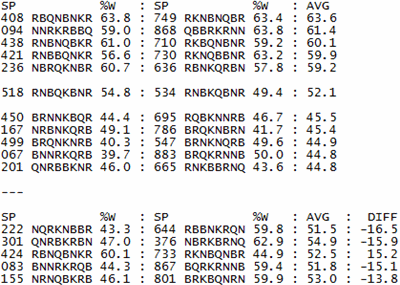Two of those five SPs were twins, positions with the pieces in reverse order relative to each other. Twins have similar characteristics for early piece development and tactics -- only different castling options distinguish them -- and early problems for Black in one twin could easily occur in the other twin. I decided it would be useful to identify other pairs of twins with high success rates for White, so I returned to the data described in the 'Yellow Flag' post to find more.
The following table shows the five twins with the highest average success rate for White (%W AVG). SP408 and its twin head the list, since they were the twins that I had already identified (the lower numbered SP is always listed in the left column). The traditional start position, SP518, and its twin are given as a reference point. The next five entries in the table are the twins with the lowest average success rate for White. If there are any start characteristics that favor Black, they might be hidden in these SPs.

At the bottom of the table are five twins with the highest difference in %W. For example, the first entry SP222 NQRKNBBR has a success rate (%W) of only 43.3%, while its twin, SP644 RBBNKRQN, has %W of 59.8%. The difference between the two values for %W is -16.5. It is of no importance that the lower numbered SP or the higher is more successful; only the absolute value of the difference is important.
Four of the five twins with the largest difference in %W have one SP in the pair where castling is possible on the first move. This indicates that the ability to castle quickly is an important defensive strategy in a difficult position. The only exception to the possibility of early castling is the third pair of twins, SP424 RBNQBNKR and SP733 RKNBQNBR. Why do these twins have such a large difference in success rate for White?
There are plenty of avenues for further investigation here, and I hope that HarryO and I will find the time to tackle a few of them. If so, I'll report on our discoveries in future posts.

No comments:
Post a Comment